It only took me five minutes in Scotland to confirm that the country’s revered islands are a wee bit under the radar — even to some Scots themselves.
My cab driver in Glasgow shared that he’d never made it off the mainland. His reason? When he has time off, he heads to warmer weather.
“Spain mostly,” he said bluntly. “I’ve even been to Florida.”
Fair enough — but this Southern California girl couldn’t wait to explore moody, wind-swept islands known for their remoteness, dramatic nature, archeological remains, thriving seabird colonies and lack of human exploitation. I looked forward to donning my weather-resistant uniform, trudging through peaty bogs in pursuit of puffins and ending each day with a warming dram of whisky.
Perhaps my vision for my visit sounds overly romantic, but I’m not the only one who’s been swept away by the idea of these faraway places. This year, Signature Travel Network named Scotland as one of its top destinations to visit for 2020.
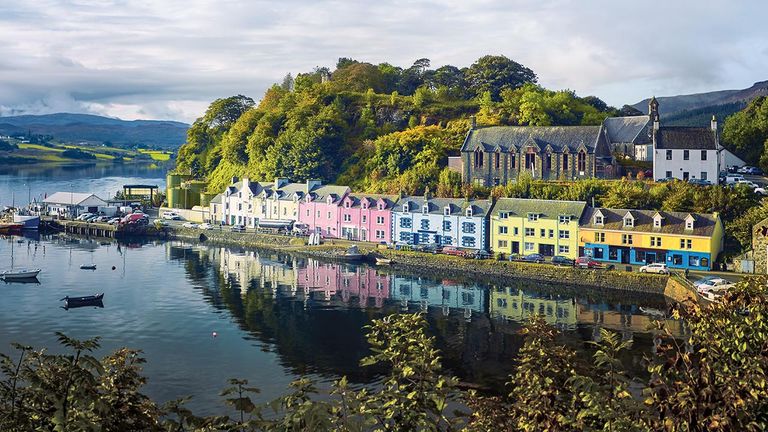 Isle of Skye, located in the Inner Hebrides, is one of the best-known offshore islands in Scotland.
Isle of Skye, located in the Inner Hebrides, is one of the best-known offshore islands in Scotland.
Credit: 2019 Getty ImagesJean Newman Glock, Signature’s managing director of communications and public affairs, says that the country is especially hot due to the television show, “Outlander.” Another draw is the diversity of new experiences now available, such as the Hebridean Whale Trail, which highlights 30 sites in the Highlands and the isles to spot whales.
“The islands are often overlooked except on a few cruise itineraries, but they are truly gems in Scotland’s crown,” Glock said. “Orkney and Shetland are my top choices. A unique mix of Scotland and Norway, they remain untouched outposts.”
According to Christine Smith, a travel consultant for Global Escapes Travel and a Signature Scotland Select expert, the Scottish isles are ideal for clients looking for authentic, off-the-beaten-path experiences, as well as for those who want to track their family heritage.
“My family moved to Canada from Glasgow, but generations ago, our clan — the McSweens — would have been from the islands,” said Matthew James “MJ” Swan, director of business development for Adventure Canada.
Many of the Scots who immigrated to the U.S. and Canada can trace their heritage from these remote locations. Some of their ancestors had left due to generally harsh conditions, while others were evicted by landlords more interested in raising sheep.
The islands are often overlooked except on a few cruise itineraries, but they are truly gems in Scotland’s crown.
Even today, the most well-traveled Scots haven’t hit all the country’s islands. And how could they? There are 790 offshore islands in Scotland spread among four major groups: the Inner Hebrides, the Outer Hebrides, Orkney and Shetland.
Furthermore, most who visit must arrive via ferry or charter boat — and visiting multiple islands is hardly seamless.
“Going by ferry is tricky and would take a couple of weeks to do,” Swan said. “Having all these places on a 10-day cruise itinerary capitalizes on time. You’re repositioning the ship each night, and you get to visit a wide variety of locations.”
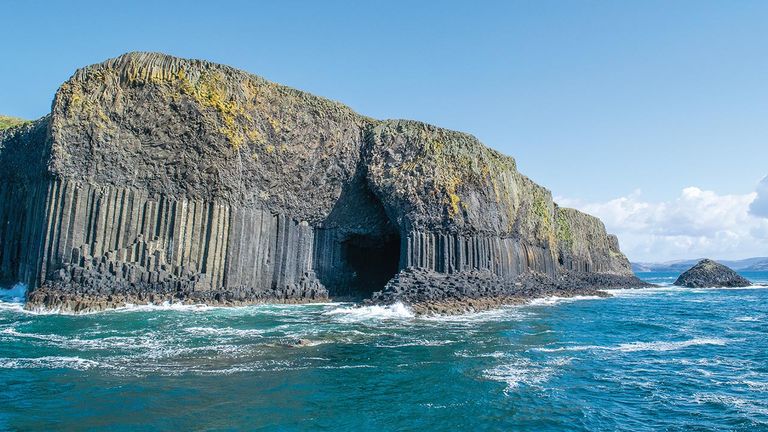 Take a boat ride through Fingal’s Cave, which features the same stone formations as Giant’s Causeway in Northern Ireland.
Take a boat ride through Fingal’s Cave, which features the same stone formations as Giant’s Causeway in Northern Ireland.
Credit: 2019 Getty ImagesThe cruise I sailed — Adventure Canada’s Scotland Slowly — is one of the most comprehensive country itineraries available and will be reprised June 14-24, 2021.
Following are some of the top isles to visit, together offering something for everyone — except, perhaps, for the traveler looking to thaw out in hotter climes.
Islay for the whiskey enthusiast
(Inner Hebrides)
With eight whisky distilleries and a Scotch-producing tradition that dates back hundreds of years, Islay (pronounced eye-lah) is a pilgrimage site for lovers of the spirit. Its bogs produce peat — organic material that is used as fuel for drying malt — which is credited for giving the single-malt whisky here an especially smoky flavor.
From Port Ellen, embark on a peaty whisky crawl by visiting Laphroaig, Lagavulin and Ardbeg, major distilleries located within miles of each other and accessible by bus. Be sure to book tours in advance since transportation and most distilleries require reservations.
Islay is also home to Finlaggan, the former seat of the Lords of the Isles. Today’s visitors will see relatively recent archeological findings, including the walls of a great hall and a former dwelling.
 Before whisky tasting, visit the former seat of the Lords of the Isles.
Before whisky tasting, visit the former seat of the Lords of the Isles.
Credit: 2019 Mindy PoderIona for the religious historian
(Inner Hebrides)
In 563 A.D., St. Columba and his clan arrived to Iona from Ireland, eager to spread the gospel to Scotland. Considered the birthplace of Christianity in Scotland, this small island — with a population of just over 100 people — features a restored and active medieval abbey, as well as a burial site said to hold the remains of 48 kings of Scotland, including Macbeth.
Iona also happens to be terribly pretty, with white-sand beaches, turquoise waters, charming ocean-front cottages and a handful of quaint inns and locally owned shops. After touring the abbey, head over to the patio of nearby St. Columba Hotel for an oversize scone and views that stretch across the Sound of Iona.
A trip to Iona can be paired with a visit to Isle of Staffa, home of Fingal’s Cave, a masterpiece of hexagonal basalt columns created from the same ancient lava flow as Giant’s Causeway in Northern Ireland.
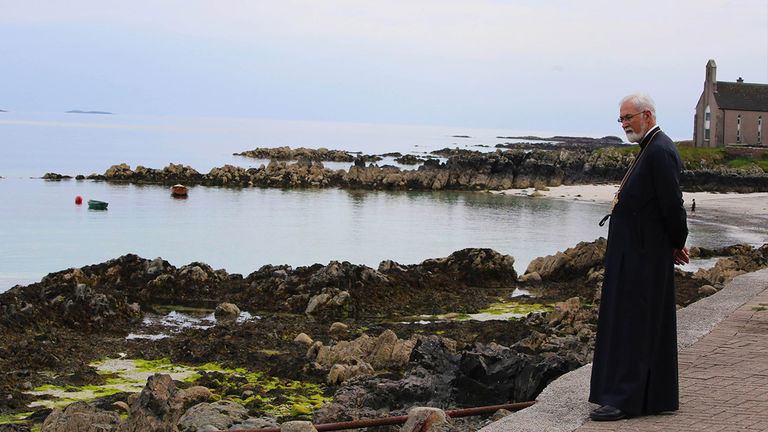 Iona is the birthplace of Christianity in Scotland.
Iona is the birthplace of Christianity in Scotland.
Credit: 2019 Mindy PoderIsle of Skye for the trekker
(Inner Hebrides)
For mountaineers, Isle of Skye is the “creme de la creme,” says David Edwards, a geologist for Adventure Canada. “It’s a landscape with great stories to tell.”
The largest island in the Inner Hebrides, Isle of Skye has plenty to offer, from famous geographical features to trails where hikers will not see another soul — with the possible exception of a red deer.
Smith of Global Escapes Travel suggests visiting the northern tip of the island, past the heavily visited sites of Kilt Rock and the Old Man of Storr.
“This is such a wild, rugged and peaceful place, ideal for avid hikers or those simply wishing to enjoy the beauty away from the tour-bus crowds,” she said. “I also love the far western coast and Neist Point Lighthouse, one of the best places in all of Scotland to view the sunset. The way the last golden rays shine on the whitecaps of the choppy sea just before the sun drops below the horizon is like something out of a fairytale.”
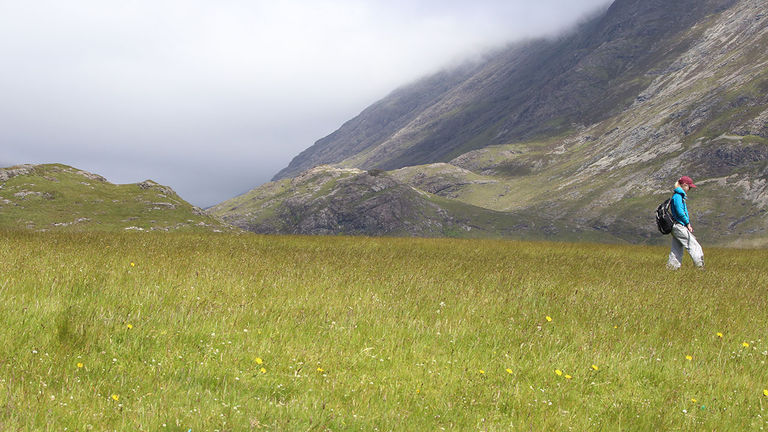 Trekkers will enjoy exploring mountainous Isle of Skye.
Trekkers will enjoy exploring mountainous Isle of Skye.
Credit: 2019 Mindy PoderSt Kilda for fans of fauna
(Outer Hebrides)
St Kilda is one of 39 UNESCO World Heritage sites that meets criteria for both its archeological and natural features.
The volcanic archipelago comprises Hirta and the nearly vertical islands of Dun, Soay and Boreray. Docking at Hirta’s beach, visitors instantly feel embraced by its semicircular shape and a grassy slope that’s so smooth in its ascent, it begs to be scaled. After tracing the island’s stone-lined amphitheater — taking care to avoid the many bird nests here — aim for the island’s highest cliffs. Visitors will weave through the archeological remains of St Kilda’s last inhabitants, who left the island and its harsh conditions by 1930.
Particularly interesting are the hundreds of cleits, small drystone storage cairns, that provide meaningful insight into the island’s history and the ingenuity of its residents.
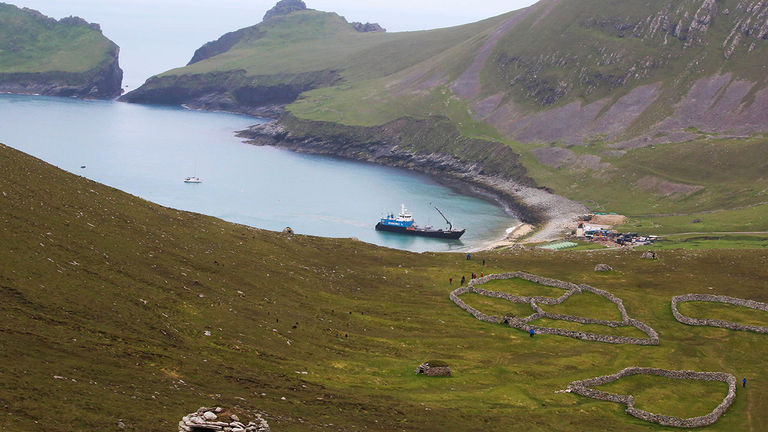 These small drystone storage units, called cleits, were used to store and preserve food, such as seabird carcasses and eggs.
These small drystone storage units, called cleits, were used to store and preserve food, such as seabird carcasses and eggs.
Credit: 2019 Mindy PoderAt the top slope, climbers are rewarded with views in all directions, including that of a superlative population of seabirds. Watch out for swooping skuas, which are known for dive-bombing lone humans who walk too close to their nests.
UNESCO World Heritage Centre calls St Kilda “a seabird sanctuary without parallel in Europe.” Expect to see dizzying amounts of northern gannets, Atlantic puffins and northern fulmars, among others; at the height of breeding season, the islands are home to nearly 1 million seabirds.
Also look out for the St Kilda wren, one of the island’s two endemic subspecies (the St Kilda field mouse is the other). Equally prevalent are Soay sheep, whose black, brown and blond wool are as embedded in the grassy landscape as the stone mounds.
 In addition to archeology, St Kilda is well known for its Soay sheep and seabirds.
In addition to archeology, St Kilda is well known for its Soay sheep and seabirds.
Credit: 2019 Mindy PoderIsle of Lewis for lovers of lore
(Outer Hebrides)
Lewis and Harris is the biggest and most populated of Scotland’s offshore islands — so big that the northern part of the island is referred to as Isle of Lewis, while the southern part is called Isle of Harris. Visitors will likely port at Stornoway, the main town of the Western Isles and home to one of the largest populations of Gaelic speakers.
Lewis has done a great job preserving its blackhouses — simple homes that were last occupied in the 1970s and did not offer running tap water — and its Harris Tweed is as protected as Scotch whisky.
But perhaps Lewis’ biggest draw is its mysterious Callanish Standing Stones, a 5,000-year-old hilltop stone circle that can be seen from miles away, often looming mystically in the mist. Even today, little is known about how or why these stones were erected here. Surrounded by lochs, this area is believed to have been accessed by these water systems.
For those who prefer pop culture over history, these stones are believed to be the inspiration for the stone circle depicted in “Outlander” that allow its main character, Claire, to travel back in time. (The show’s stones were made from Styrofoam, but Callanish’s stones are the real deal.)
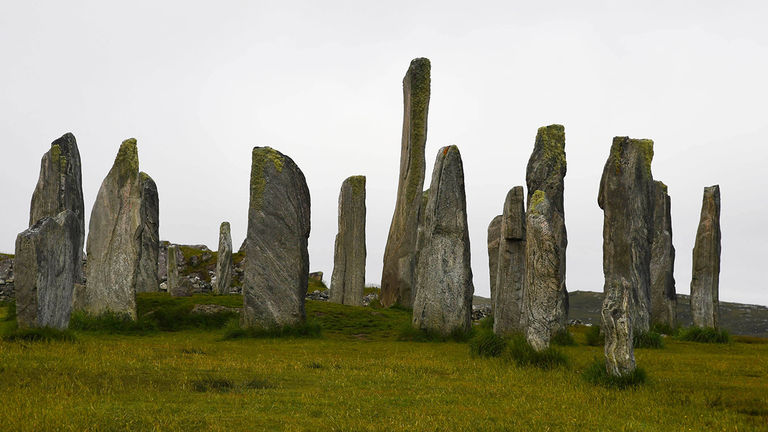 Little is known about how and why the Callanish Standing Stones were erected.
Little is known about how and why the Callanish Standing Stones were erected.
Credit: 2019 Mindy PoderFair Isle for puffin lovers
(Shetland)
In between Mainland Orkney and Mainland Shetland is Fair Isle. While Fair Isle was once home to some 400 people, it now has about 55 residents — but makes up for the lack of people with, what else, seabirds. Though the Fair Isle Bird Observatory is being rebuilt after sustaining damage in a fire, visitors will spot seabirds all around the scenic island.
During my visit, hundreds of puffins gathered on the edges of the island’s plunging cliffs and in interconnected burrows that reminded me of Skara Brae’s Earth-engulfed environs.
A group of fellow travelers watched spellbound as the cartoonish orange-beaked birds collected tufts of wool, pink wildflowers and other debris; flew in and out of underground holes; rubbed beaks at one another — and even at the toe of my hiking boot (which an ornithologist told me marked the start of a mating ritual). We kept a respectful distance as we watched the birds but, like good local hosts, they seemed curious about us, too.
Mousa for seekers of unpeopled places
(Shetland)
Uninhabited since the 19th century, Mousa is part of a sheep farm and, indeed, sheep greet visitors as they begin to explore. Mousa is also home to seals and numerous birds, including Arctic terns. Notable for their translucent wings, the birds have large nesting areas, which they aggressively protect, so it’s advisable to walk in a group.
Mousa is also home to the oldest and most intact Iron Age broch in the area. The waterfront broch is in excellent condition, allowing visitors to analyze how stonemasons created thick walls without mortar through dry stone construction. Look out for naturally occurring gaps in the wall — they double as burrows for nesting storm petrels (the island is home to thousands of the small bird).
Clients can ascend the narrow and winding stairs to the open-air rooftop which provides panoramic views of the area, ideal for contemplating the purpose of these mysterious structures.
 The uninhabited island of Mousa is the site of one of Scotland’s best-preserved Iron Age brochs.
The uninhabited island of Mousa is the site of one of Scotland’s best-preserved Iron Age brochs.
Credit: 2019 Mindy PoderMainland Orkney for the wannabe archeologist
(Orkney)
Spend enough time in Orkney, and you’ll unearth your own desire to be an archeologist. According to UNESCO World Heritage, Orkney’s sites — grouped into the “Heart of Neolithic Orkney” listing — “are unquestionably among the most important Neolithic sites in Western Europe.”
Considered the Pompeii of the U.K., the Skara Brae settlement is the must-see of the UNESCO listing. Built into the ground and hidden under sand for centuries, the eight oceanside stone dwellings that make up the Skara Brae village depict a communal society inhabited for 600 years between 3200 B.C. and 2200 B.C.
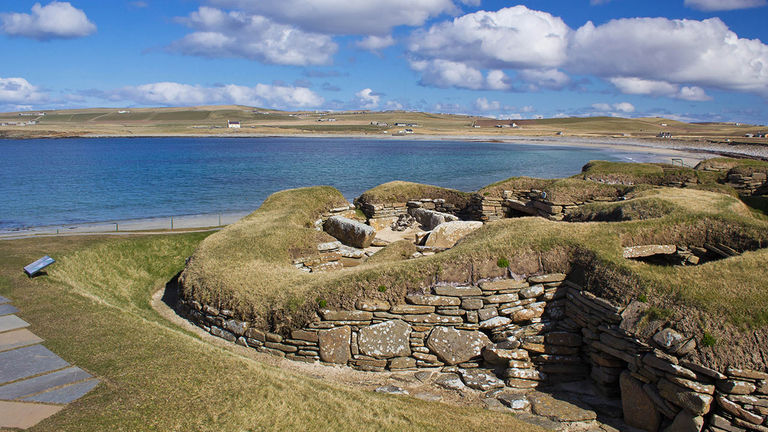 Skara Brae, considered the “Pompeii of the U.K.” is located in Mainland Orkney.
Skara Brae, considered the “Pompeii of the U.K.” is located in Mainland Orkney.
Credit: 2019 Getty ImagesAlso part of the UNESCO listing are Maeshowe, a large chambered tomb, and two ceremonial stone circles called Stones of Stenness and Ring of Brodgar.
Orkney is also significant for its Norse roots: The largest town in Orkney, Kirkwall comes from “Kirkjuvagr,” which means “church on the bay.” This is likely a reference to St. Magnus cathedral, a medieval structure and resting place for St. Magnus’ relics. The red and yellow sandstone building is in the center of the charming town and is surrounded by gift shops, whisky tasting rooms, ice cream shops and low-key cafes.